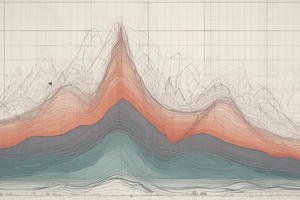Podcast
Questions and Answers
When should error bars be included on a graph?
When should error bars be included on a graph?
- To enhance the visual appeal of the graph, regardless of data properties.
- Error bars should be included as a decorative element on all graphs.
- When the data has a high degree of variability or uncertainty. (correct)
- When the source data is known to be perfectly accurate.
What is the effect of using unclear graph layouts?
What is the effect of using unclear graph layouts?
- It makes the data easier to interpret.
- It has no impact on data interpretation as long as the numbers are correct.
- It introduces ambiguity and increases the chance of misinterpretation. (correct)
- It enhances data accuracy.
A researcher wants to display the correlation between two continuous variables. Which type of graph is most suitable?
A researcher wants to display the correlation between two continuous variables. Which type of graph is most suitable?
- Pie chart
- Bar graph
- Histogram
- Scatter plot (correct)
What should be considered to ensure data findings are communicated effectively?
What should be considered to ensure data findings are communicated effectively?
Which action can help improve understanding of complex information presented in a graph?
Which action can help improve understanding of complex information presented in a graph?
Which type of graph is most suitable for displaying the change in temperature of a city over a week?
Which type of graph is most suitable for displaying the change in temperature of a city over a week?
A researcher wants to visualize the correlation between study time and exam scores for a group of students. Which type of graph should they use?
A researcher wants to visualize the correlation between study time and exam scores for a group of students. Which type of graph should they use?
A data analyst needs to represent the proportion of different departments' budgets relative to the total budget of a company. What graph is most effective?
A data analyst needs to represent the proportion of different departments' budgets relative to the total budget of a company. What graph is most effective?
Which graph element is essential for interpreting a graph that contains multiple data series?
Which graph element is essential for interpreting a graph that contains multiple data series?
A quality control engineer measures the width of bolts produced by a machine. They want to display the distribution of these widths. What graph should they use?
A quality control engineer measures the width of bolts produced by a machine. They want to display the distribution of these widths. What graph should they use?
A researcher records plant growth under different light conditions and wants to show variability in growth for each condition including median, quartiles, and outliers. Which graph is ideal?
A researcher records plant growth under different light conditions and wants to show variability in growth for each condition including median, quartiles, and outliers. Which graph is ideal?
Which software is most suitable for creating basic graphs if the user needs a simple, user-friendly experience?
Which software is most suitable for creating basic graphs if the user needs a simple, user-friendly experience?
In a scatter plot showing the relationship between fertilizer use and crop yield, what do the individual data points represent?
In a scatter plot showing the relationship between fertilizer use and crop yield, what do the individual data points represent?
Flashcards
Graphs
Graphs
Visual representations of data used to reveal patterns, trends, and relationships.
Plotting
Plotting
Marking data points on a graph to show variation in data.
Line Graphs
Line Graphs
Graphs that display trends over time or continuous data.
Bar Graphs
Bar Graphs
Signup and view all the flashcards
Scatter Plots
Scatter Plots
Signup and view all the flashcards
Histograms
Histograms
Signup and view all the flashcards
Box Plots
Box Plots
Signup and view all the flashcards
Axes
Axes
Signup and view all the flashcards
Types of Data
Types of Data
Signup and view all the flashcards
Message of a Graph
Message of a Graph
Signup and view all the flashcards
Importance of Graphing
Importance of Graphing
Signup and view all the flashcards
Common Graphing Errors
Common Graphing Errors
Signup and view all the flashcards
Graph Construction Considerations
Graph Construction Considerations
Signup and view all the flashcards
Study Notes
Introduction to Graphs and Plotting
- Graphs are visual representations of data, revealing patterns, trends, and relationships.
- Plotting involves marking data points systematically on a graph, illustrating data variation.
- Choosing the right graph type is crucial for effectively communicating data's message.
Types of Graphs
- Line graphs: Display trends over time or continuous data; useful for showing variable changes over a period.
- Bar graphs: Compare different categories or groups; ideal for discrete data or comparing values across categories.
- Scatter plots: Illustrate relationships between two variables; visually identify correlations.
- Histograms: Show the distribution of a single variable; illustrate frequency distributions.
- Pie charts: Show proportions of categories within a whole; excellent for percentages and proportions.
- Box plots: Display the distribution of a variable, showing median, quartiles, and outliers; useful for comparing data distributions across categories.
Graph Elements
- Axes: Horizontal (x-axis) and vertical (y-axis) lines defining the scale and units of measurement.
- Title: A descriptive name explaining the graph's purpose and contents.
- Labels: Clearly indicate the variable and units (e.g., "Time (hours)" or "Temperature (°C)").
- Data points: Represent individual data values on the graph.
- Legend: Explains symbols or colors in graphs with multiple data series.
- Gridlines: Help visualize data values and interpretation.
- Error bars: Visually show uncertainty or variability in data measurements.
Plotting Software and Tools
- Spreadsheet software (e.g., Microsoft Excel, Google Sheets): Easy for creating basic graphs.
- Specialized graphing software (e.g., MATLAB, R): Provides advanced features for complex plots and customization.
- Python libraries (e.g., Matplotlib, Seaborn): Offer great control over graph design, customization, and data manipulation.
Choosing the Right Graph Type
- Consider the data type (quantitative or qualitative).
- Consider the message to be conveyed (trend or comparison).
- Consider the audience.
- Avoid cluttered graphs; use clear and simple visual representations.
Interpretation of Plots
- Analyze trends and patterns in the data.
- Identify correlations between variables.
- Calculate statistics from the plots.
- Draw conclusions from analyzed data.
Importance of Graphing
- Clearly and concisely explains data findings.
- Facilitates understanding of trends and patterns.
- Supports hypothesis evaluation and scientific analysis.
- Aids in identifying correlations and relationships between variables.
- Improves communication of complex information.
Common Errors in Graphing
- Choosing inappropriate graph types.
- Using an inappropriate scale.
- Insufficient or misleading labels/titles.
- Lack of clarity and visual appeal.
- Neglecting error bars when needed.
- Misleading use of colors/symbols.
- Omitting crucial data.
Considerations for Graph Construction
- Accuracy: Graphs must accurately reflect data.
- Clarity: Easy-to-understand layout reduces ambiguity.
- Efficiency: Communicate the message simply, reducing clutter.
- Visual Appeal: Graphs should be visually appealing for better insights.
Studying That Suits You
Use AI to generate personalized quizzes and flashcards to suit your learning preferences.




